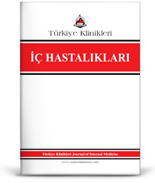Amaç: Kan ve kan bileşenlerinin transfüzyonu sırasında ya da sonrasında basit reaksiyonlardan hayatı tehdit eden reaksiyonlara kadar geniş spektrumda klinik sonuçlara yol açan komplikasyonlar gelişebilmektedir. Bu çalışmanın amacı, akut dönemde gelişen transfüzyon reaksiyonlarının sıklığını saptayarak gelişebilecek komplikasyonların erken tanınması ve yönetilmesindeki farkındalığı artırmaktadır. Gereç ve Yöntemler: Araştırmamız Okmeydanı Eğitim ve Araştırma Hastanesi İç Hastalıkları ve Hematoloji Kliniğinde Kasım 2018 ile Temmuz 2019 tarihleri arasında tek merkezli olarak yürütülmüştür. Komplikasyonlar Türk Hematoloji Derneği güncel kılavuzlarına göre sınıflandırılmıştır. İç hastalıkları ve hematoloji kliniğine çeşitli nedenlerle yatışı yapılan ve transfüzyon yapılan 1.000 hasta çalışmaya dâhil edilmiştir. Bu hastaların yatış nedenleri, kan transfüzyonu endikasyonları, transfüzyon tarihi, verilen kan ürünü, cross match uyumu, kan ürünlerine ışınlama veya lökosit filtrasyonu gibi uygulanan işlemler, doğum, küretaj ve abortus öyküsü, önceki kan transfüzyonu ve komplikasyon öyküsü sorgulanarak kaydedildi. Hastalarda akut dönemde gelişen reaksiyonlar kaydedildi. Bulgular: Çalışmamızdaki hastaların 553'ü (%55,30) erkek, 447'si (%44,70) kadınlardan oluşmaktadır. Dokuz yüz elli sekiz (%95,80) hastada kan transfüzyon reaksiyonu gözlenmemiştir. Kırk iki hastada akut reaksiyon gözlenmiştir. Hastaların 29'unda (%2,9) febril reaksiyon, 8'inde (%0,8) alerjik reaksiyon, 1'inde (%0,1) alerjik reaksiyon + febril reaksiyon, 2'sinde (%0,2) hipertansiyon, 1'inde (%0,1) volüm yüklenmesi ve 1'inde (%0,1) akut hemolitik reaksiyon gözlendi. Sonuç: Çalışmamızda akut dönemdeki transfüzyon reaksiyon oranları literatüre göre daha yüksek oranda bulunmuştur. Komplikasyonların sıklığının bilinmesi, erken fark edilmesi ve uygun şekilde yönetilmesi hayati öneme sahiptir.
Anahtar Kelimeler: Akut hastalık; kan; kan transfüzyon; transfüzyon reaksiyon
Objective: Reactions may occur during or after transfusion of whole blood and blood components. These reactions can lead to a broad spectrum of clinical outcomes, from simple reactions to lifethreatening reactions. The aim of this study is to raise awareness of early recognition, management and prevention of the reactions and showing the frequency of acute period blood transfusion complications. Material and Methods: Our study was carried out in a single center between November 2018 and July 2019 in the Department of Internal Medicine and Hematology of Okmeydanı Training and Research Hospital. Transfusion reactions are classified according to Turkish Haematology Association updated guidelines. One thousand patients who were admitted to the internal medicine and hematology clinic for various reasons and were transfused were included in the study. The reasons for hospitalization, blood transfusion indications, date of transfusion, blood product given, cross match compliance, procedures such as irradiation to blood products or leukocyte filtration, history of birth, curettage and abortion, previous blood transfusion and complication history were questioned and recorded. Reactions that developed in the acute period were recorded. Results: Five hundred fifty-three (55.30%) patients were male and 447 (44.70%) were female in the study. Blood transfusion reactions were not observed in 958 (95.80%) patients. Acute reactions were observed in 42 patients. Febrile reaction in 29 (2.9%) patients, allergic reaction in 8 (0.8%) patients, allergic reaction + febrile reaction in 1 (0.1%) patient, hypertension in 2 (0.2%) patients, volume overload in 1 patient (0.1%) and acute hemolytic reaction was observed in 1 (0.1%) patient. Conclusion: In our study, transfusion reaction rates in the acute period were found to be higher than in the literature. Knowing the frequency of complications, detecting them early and managing them appropriately is vital.
Keywords: Acute disease; blood; blood transfusion; transfusion reaction
- Osterman JL, Arora S. Blood product transfusions and reactions. Hematol Oncol Clin North Am. 2017;31(6):1159-70. [Crossref] [PubMed]
- Learoyd P. The history of blood transfusion prior to the 20th century--part 1. Transfus Med. 2012;22(5):308-14. [Crossref] [PubMed]
- Politis C, Wiersum JC, Richardson C, Robillard P, Jorgensen J, Renaudier P, et al. The international haemovigilance network database for the surveillance of adverse reactions and events in donors and recipients of blood components: technical issues and results. Vox Sang. 2016;111(4):409-17. [Crossref] [PubMed]
- Kato H, Uruma M, Okuyama Y, Fujita H, Handa M, Tomiyama Y, et al. Incidence of transfusion-related adverse reactions per patient reflects the potential risk of transfusion therapy in Japan. Am J Clin Pathol. 2013;140(2):219-24. [Crossref] [PubMed]
- Savage WJ, Tobian AA, Fuller AK, Wood RA, King KE, Ness PM. Allergic transfusion reactions to platelets are associated more with recipient and donor factors than with product attributes. Transfusion. 2011;51(8):1716-22. [Crossref] [PubMed] [PMC]
- Sharma S, Sharma P, Tyler LN. Transfusion of blood and blood products: indications and complications. Am Fam Physician. 2011;83(6):719-24. [PubMed]
- Kumar R, Gupta M, Gupta V, Kaur A, Gupta S. Acute transfusion reactions (ATRs) in intensive care unit (ICU): a retrospective study. J Clin Diagn Res. 2014;8(2):127-9. [PubMed] [PMC]
- Sahu S, Hemlata, Verma A. Adverse events related to blood transfusion. Indian J Anaesth. 2014;58(5):543-51. [Crossref] [PubMed] [PMC]
- Sarı İ, Altuntaş F. Transfüzyon ilkeleri ve erken komplikasyonlar [Transfusion principles and early complications]. Türk Hematoloji Derneği-Hematolojide Destek Tedavileri ve İnfeksiyonlar Kursu. 2007. [Link]
- Ezidiegwu CN, Lauenstein KJ, Rosales LG, Kelly KC, Henry JB. Febrile nonhemolytic transfusion reactions. Management by premedication and cost implications in adult patients. Arch Pathol Lab Med. 2004;128(9):991-5. [Crossref] [PubMed]
- Riley W, Smalley B, Pulkrabek S, Clay ME, McCullough J. Using lean techniques to define the platelet (PLT) transfusion process and cost-effectiveness to evaluate PLT dose transfusion strategies. Transfusion. 2012;52(9):1957-67. [Crossref] [PubMed]
- Hatayama Y, Matsumoto S, Hamada E, Kojima N, Hara A, Hino N, et al. Analysis of acute transfusion reactions and their occurrence times. Yonago Acta Med. 2018;61(1):87-90. [Crossref] [PubMed] [PMC]
- T.C. Sağlık Bakanlığı. Ulusal Kan ve Kan Ürünleri Rehberi. Türkiye Kan Merkezleri ve Transfüzyon Derneği. 2011. [Link]
- Azizi S, Tabary SZ, Soleimani A. Prevalence of acute blood transfusion reactions in Mazandaran Heart Center, Sari, Iran, 2010-2012. Med Arch. 2014;68(2):137-9. [Crossref] [PubMed] [PMC]
- Borhany M, Anwar N, Tariq H, Fatima N, Arshad A, Naseer I, et al. Acute blood transfusion reactions in a tertiary care hospital in Pakistan - an initiative towards haemovigilance. Transfus Med. 2019;29(4):275-8. [Crossref] [PubMed]







.: Process List